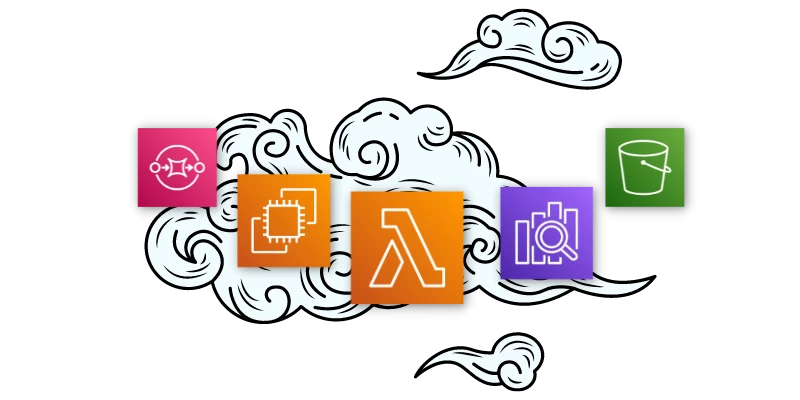
Caylent Services
Application Modernization
Innovate at the speed of light with modern applications powered by modular architectures running on purpose-built AWS services.
Best practices for modern architecture, orchestration, automation, and more.
Modernizing legacy applications enables your business to move fast! By modernizing your legacy applications to leverage cutting-edge cloud infrastructure, you can improve performance, reduce costs, make quicker business decisions, and increase reliability, availability, and flexibility. This application modernization journey can be a significant effort, but you have many choices in how you plan for it. With good preparation and solid decision-making, you can modernize your application and begin reaping the benefits.
A successful application modernization project should result in several benefits, and it will be up to you to pursue the benefits that are most important or meaningful for your application.
As a starting point, consider the example of running a custom, on-prem application hosted on physical servers in your data center. This scenario could encounter several difficulties:
Each of these issues can be addressed through application modernization.
Rehosting from physical servers to EC2 instances would improve scalability while removing the need to overprovision. Replatforming by moving to containers would further enable efficient usage of infrastructure while making your application portable, scalable, and reliable. And using cloud-managed services as part of your legacy modernization solves problems with patching, security compliance, server upgrades, reliability, and more. The final, and many times most challenging, approach is refactoring or rearchitecting your application. This takes more time, energy, and money but results in extreme improvements in the areas of performance, extensibility, and future-proofing, alongside all of the other benefits mentioned above.

A modernized application should have the following key traits:
Be Cloud Native: modern apps should utilize and integrate with cloud services. Only by living in the cloud can your application leverage the benefits of cloud computing, such as extreme scalability, cost efficiency, and agility.
Follow a Modern Architecture: for example, use a microservices architecture to decouple monolithic functionality into smaller, discrete modules that can be updated and deployed independently for greater flexibility and improved performance.
Use Modern Components: for example, leverage containers to package, deploy, and operate your application to achieve scalability, portability, and operational efficiency.
Incorporate Modern Development: use modern frameworks to save time writing new code by using established patterns and templates, and improve developer efficiency through proven development processes. Use modern languages that can speed up coding time, open the door to new development techniques, and attract the brightest talent to your team.
Employ Orchestration and Automation: coordinate and manage automations to create cohesive, easily repeatable, rules-based workflows. Orchestration is commonly used in container deployment automation, but can also be leveraged for application deployment automation, such as the workflow in a CI/CD pipeline. This saves developer time by automating repetitive tasks and increases app quality through automated testing and validation.
Preparation is arguably the most important step in your application modernization journey. Defining the business outcomes required for success and iterating through the timeline, milestones, priorities, and other drivers will all be key elements of successful preparation. Successful and detailed preparation enables you to set realistic goals and milestones with users and stakeholders.
The preparation phase of your application modernization checklist should include identifying, documenting, and prioritizing the following:
An application assessment will require input from your technology teams and business teams who support and maintain the app, users who rely on the app, and stakeholders who will play a role in the app modernization. Collaborate with your technology experts, power users, and cross-business teams to define where each part of the checklist below belongs on the continuum from critical to not applicable.
Special attention should be given to include secondary or even tertiary stakeholders. For example, even if the database team doesn’t support the legacy application directly, they could be impacted by the modernization effort and should be consulted or informed.
Customize the checklist to fit your needs since it is likely your environment includes unique circumstances that will need special handling.
The app assessment phase of your application modernization checklist should include identifying and documenting the following:
Once the application assessment is complete, you will have a rich data source for deciding the best modernization method and strategy for your application. And based on criticality and priority, you can decide to focus on the biggest pain points first or on the business outcomes you want to achieve first.
The roadmap phase of your application modernization checklist should include identifying and documenting the following:
If you decide moving your app to containers should be part of your modernization strategy, you will have additional decisions to make. Containerization will require planning and good execution, but when done right, containers bring significant benefits in cost reduction, app portability, scalability, dependability through standardization, and efficient use of resources.
The containerization phase of your application modernization checklist should include making decisions in the following areas:
When it comes to options for application modernization, refactoring can be the best approach to take, but it can also be the most scary and resource intensive. Refactoring gives you the ability to rework and improve vast swaths of your application (if not the whole thing) and gives you laser-like precision in how your application gets modernized. Whether it’s decomposing a monolith into microservices or refactoring code to be more concise, refactoring can help you to meet your exact goals.
The refactoring phase of your application modernization checklist should include making decisions in the following areas:
A crucial piece of a modernized application is the implementation of a deployment pipeline. This orchestrated, standardized process will save time, increase productivity, improve quality, remove error-prone manual steps, enable automated testing, and deploy a stable, reliable version of the application to the right environments.
The pipeline phase of your application modernization checklist should include making decisions in the following areas:
Application modernization comes with many benefits, and it is easy to focus on all the great things to look forward to. But, of course, there are pitfalls to watch out for. If done incorrectly, an application modernization journey can be delayed, derailed, expensive, or downright destructive.
Examples of pitfalls include misaligned business goals, taking shortcuts, not having everyone on board and the potential for high investment requirements, as mentioned above.
There are also best practices that can help achieve successful modernization:
Ensure readiness gets the attention it deserves: don’t take shortcuts during preparation and readiness. Give full time and attention to research, documentation, and decision-making during these early stages.
Modernize using a granular approach: build a component-based or functionality-based roadmap with clear milestones, priorities, and timelines. Focus on granular pieces rather than trying to update everything all at once.
Get everyone on board: ensure stakeholders, users, decision-makers, and especially the technical teams see the benefits and are buying into the work. A quick way to derail modernization is to not take care of your team or allow them to be impacted negatively.
Make wise technical choices for the right reasons: choosing a framework, language, or development methodology always has big pros and cons. Do the research to choose wisely and confidently, and guard against trend following, making assumptions, or being misinformed.
Healthy organizations are always working to modernize: application modernization is not a one-time event, and when completing a project, there is always another application that could benefit from modernizing. Show a bias for action and proactively look for your next modernization need. Don’t let inaction turn an application into a legacy application.
Application modernization is a big topic, and even the best checklist doesn’t guarantee results. Our Cloud Native Applications practice at Caylent can help you navigate and conquer the strategies and the pitfalls. We have helped our clients modernize applications, and we can help you achieve the application modernization goals and requirements you need for your business. As a Premier Tier AWS consulting partner and the AWS Innovation Partner of the Year, we are here to help you achieve great outcomes for your business.
We are forward-thinking technical experts, and we pride ourselves on true partnerships with our customers. Being a partner means engaging together in a focused effort to solve your problems, drive your vision forward, and achieve measurable technical and business results.
We are all in on AWS. We have deep expertise and knowledge, and your application modernization will be delivered by AWS certified architects and software engineers.
We are trusted and proven. We consistently achieve 9.5+ CSAT scores with our clients, and we will bring this same level of excellence to your project.
We have broad industry specializations in the areas of SaaS, Healthcare, Life Sciences, Financial Services, Insurance, Education, and Transportation.
Check out how Caylent can accelerate your application modernization journey and help you achieve your cloud native goals. We’d love to learn more about your business and application modernization goals.

Chris Kemp is a Delivery Manager in the Cloud Native Applications practice at Caylent. He enjoys partnering with clients to implement AWS solutions using modern technologies and architectures. His many years in the software industry include application development, technical product management, team leadership, and co-founding a startup. Chris originally hails from the desert southwest but now calls the Dallas, TX area home. He strongly believes New Mexico green chile is the best condiment in the world, but has come to enjoy Tex-Mex too.
View Chris's articles

Discover how Amazon Q Developer is redefining developer productivity - featuring a real-world migration of a .NET Framework application to .NET 8 that transforms weeks of manual effort into just hours with AI-powered automation.

Learn best practices for building resilient IT systems on AWS to ensure reliability, security, and high availability in the face of failures and disruptions.

Explore security best practices for Amazon Elastic Kubernetes Service (EKS) to help maintain a strong security posture.